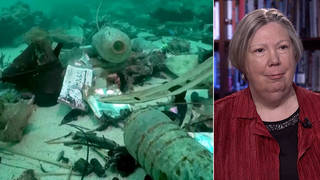
Topics
Alarmed at the spread of mad cow disease from Britain to Spain, France and Germany, the European Union this week announced the slaughter of all untested cows older than 30 months. It also imposed a total ban on feeding animal parts to livestock. [includes rush transcript]
The EU fears a repeat of Britain’s experience, where an epidemic of mad cow disease devastated the country’s beef industry, triggered the slaughter of 200,000 cows, and spread to humans. The cows, natural herbivores, became infected through feed containing animal parts. More than 70 people are known to have contracted the always fatal neurological disease–presumably after eating beef.
But since the incubation for the human form of mad cow disease can be decades long-no one may know how many people have been infected but do not yet show symptoms. Now, many are questioning whether U.S. beef is safe.
Guests:
- Deborah Mackenzie, Brussels correspondent for the London magazine “New Scientist.”
- Gary Weber, Executive Director of Regulator Affairs at the National Cattlemen’s Beef Association.
- John Stauber, Co-author of the book “Mad Cow USA.”
Transcript
AMY GOODMAN: We’re going to turn now to the issue of mad cow disease. After a tumultuous session, the European Union, alarmed at the spread of mad cow disease from Britain to Spain, France and Germany, announced the slaughter of all untested cows older than thirty months. It also imposed a total ban on feeding animal parts to livestock.
The EU fears a repeat of Britain’s experience, where an epidemic of mad cow disease devastated the country’s beef industry, triggering the slaughter of 200,000 cows. The cows, natural herbivores, became infected through feed containing animal parts. More than seventy people are known to have contracted the always-fatal neurological disease, presumably after eating beef.
But since the incubation period for the human form of mad cow disease can be decades long, no one knows how many people have been infected but have yet show symptoms.
We’re going to go first to Deborah MacKenzie, who is the Europe correspondent for the New Scientist magazine, speaking to us from Brussels. Welcome to Democracy Now!
DEBORAH MacKENZIE: Hello.
AMY GOODMAN: Hi. Can you tell us about the European Union decision?
DEBORAH MacKENZIE: Well, what happened was that a lot of people, a lot of countries, governments on the continent of Europe were sort of thinking of mad cow disease as being largely a British problem. There are a number of countries here that had a few cases here and there, but by and large everybody was sort of hoping it would sort of more or less remain confined to Britain, and several countries weren’t doing a very good job of looking for it.
What happened was that the French suddenly decided to go out and actually look very carefully for mad cow disease. They were fairly confident they wouldn’t find very much. And in fact they found about, you know, ten times as much as they were expecting to, which scared them. And then, lo and behold, the first cases turn up in Germany and Spain.
Well, some people have been predicting this for a long time. But the governments were trying to ignore it. They couldn’t ignore it any longer. And what happened was — well, there was a lot of consumer panic. And everyone got together and decided that they had better do something drastic.
AMY GOODMAN: We’re also joined on the phone by Gary Weber, who is the Executive Director of Regulator Affairs for the National Cattlemen’s Beef Association. An EU report listed the US as a country where mad cow disease could not be ruled out. Is US beef safe, Gary Weber?
GARY WEBER: Yes, it is. In fact, as was just mentioned, the concerns about countries of Europe, we’ve monitored that for some time and actually in '97 supported the USDA Animal and Plant Health Inspection Service to put additional restrictions on the export of cattle, beef, and beef products from all European countries, because our intelligence was providing us with insights that they may have a problem there. So we've continued to take some very aggressive steps in the United States to protect the health of the cattle herd and, of course, the health of our consumers.
AMY GOODMAN: John Stauber also joins us, who’s co-author of Mad Cow USA. Are you as confident about the US beef supply?
JOHN STAUBER: No, I’m not at all. And I think that Gary’s words highlight a problem with the attitude in the United States that Deborah referred to. The livestock industry in the United States, the US government, and the EU all shared the same myopic view of this problem, saying that the problem is British mad cow disease, and it can’t happen here. What I’m really concerned about in the United States isn’t BSE, per se. That’s a very specific strain that’s broken out in Britain and spread to Europe. No surprise since in 1988, when Britain began banning contaminated feed, it exported that feed to Europe. And in our book, Mad Cow USA, we certainly predicted what’s happening in Europe.
What’s happening in the United States that is very frightening is that we have our own forms of mad cow-type diseases. We have TSE diseases, which these are called in scrapie in the US, and most frighteningly, we have a type of mad deer and mad elk disease that’s now at epidemic levels in Western states. And in just the last two years, at least two young hunters under the age of thirty have come down with the human equivalent of mad cow disease. And they may have picked that up from deer and elk.
Now, we have a huge rendering industry in the United States. And we have the most lax laws regarding this practice of animal cannibalism, feeding slaughterhouse waste back to animals. And in the United States, it is legal to feed deer and elk and sheep infected with mad cow-type diseases to pigs, for instance. And it’s legal then to feed pig slaughterhouse waste to cows. So we have huge loopholes in our regulations here. And all this focus on British mad cow disease is hiding the fact that we have US types of mad cow disease that very well could already be spreading through our livestock.
AMY GOODMAN: Gary Weber of the National Cattlemen’s Beef Association?
GARY WEBER: Well, we put in place some very stringent bans on the feeding of all bone meal to cattle and except, as John is mentioning, from poultry byproducts to pork byproducts, which are still allowed. Fortunately, we don’t think that there is any science to suggest that that kind of backdoor route is realistic. There’s no evidence to support that. But also we continue to monitor the United States for the presence of diseases in cattle. We have doubled our submissions of brain samples. We’re using the best technology. It’s a little bit slow, but we have a far more sensitive set of tests than they’re using in Europe, based on immunohistochemistry. And we continue to really encourage very aggressive surveillance of these diseases.
And relative to chronic wasting disease, it really is limited to a few counties in a few states in the West. And we have been very aggressive in supporting the elk industry and taking very stringent action against that. And we have been supporting research to see if that disease is transmissible to cattle and other animals [inaudible].
AMY GOODMAN: Let’s go back to Deborah MacKenzie in Brussels for a minute, who has been following the European Union negotiations. The second major measure adopted by the EU is a feed ban. Currently all EU countries, except the UK, feed meat and bone meal from slaughtered animals, including cattle, to pigs, chickens and fish. Explain the ban and how the US policy differs.
DEBORAH MacKENZIE: Actually, could I do that in a minute? I’d like to respond to a couple of points the last speaker made. First of all, you do not have a more sensitive test in the United States. Secondly, you’ve tested a very, very small proportion of your livestock. You’re doing what Germany did. You’re not looking very hard for prion-type diseases in general. And thirdly, you say that there’s no science to suggest that, you know, CWD, for example, chronic wasting disease in elk, could possibly get into livestock through pigs or something. There’s no science to suggest it, because there’s no science that’s been done. The British made that mistake for many years. They said there’s no evidence. I quote a very famous line that is often quoted in respect to these diseases: “Absence of evidence is not evidence of absence.” I would like to see somebody feed some mad elk to some pigs and then look for infectivity.
To get back to your question about feeding MBM, rendered animals, to livestock, the same situation prevails in Europe. On the continent, they have been allowing the feeding of ground-up cattle to pigs and chickens. That has now been banned, largely because they were scared that some of that feed was getting back to cows and that was how the disease was still spreading in cows. In fact, to my mind, what’s very frightening about that is precisely what was suggested a minute ago might be the case for chronic wasting disease in elk, in that you feed something to a pig, you don’t know if that pig is then infectious, because it’s actually never been tested. And on the continent of Europe, where we now know that there is a great deal more mad cow disease than we were admitting in the past, we know for sure now that we’ve been feeding rendered mad cows to pigs and chickens. And no one’s actually ever done the experiment of feeding a mad cow to a pig and then grinding up tissue from that pig and giving it to a sensitive species and seeing whether that pig is infectious. Now, it’s the absence of evidence that frightens me.
AMY GOODMAN: That’s Deborah MacKenzie, Europe correspondent for the New Scientist magazine. Gary Weber, your response? And also, is the National Cattlemen’s Beef Association the national arm of the group that has sued Oprah Winfrey, challenging her for saying she didn’t want to eat hamburgers?
GARY WEBER: No, we never sued Oprah Winfrey. I happened to have been on the show, but a group of cattle producers independently sued her for some comments that a gentleman made on the show, but we were not involved with. And I was the participant in that event.
AMY GOODMAN: Were you opposed to that suit?
GARY WEBER: I felt that she was very fair about how she had offered us an opportunity to come on the show a second time live to state the facts, that we’ve been very aggressive here.
AMY GOODMAN: I just raise it, because I think there’s not a lot of discussion in this country about the issues of mad cow and the whole meat industry. And I think that suit helps — even though she won — to squelch people from engaging in discussion, because they’re afraid. They don’t have the resources of Oprah to handle these multi-million-dollar corporate lawsuits.
GARY WEBER: Back to the question of our testing, actually, I would differ on our rigor of our surveillance program. We’re actually targeting animals over thirty months of age, which are the animals that would be at risk. We’re targeting animals that have symptoms of neurological disease. We’re using immunohistochemistry technology, which is more sensitive than the Prionics test, for instance, that the Swiss are using. We know the government is looking at even more sensitive tests, which we support. So I think that we have a very good system. The OIE, the international body that monitors animal health globally, associated with the WTO, has referenced our system as at least adequate and we’re buffering it — buttressing it even more.
Relative to chronic wasting disease, we actually have research underway where they have injected into the brains of cattle the brains from infected elk. So those studies are underway, so —
DEBORAH MacKENZIE: Well, I’m glad to hear that. But do you feed infected elk to cattle, or do you feed them to pigs?
GARY WEBER: Well, number one, and there aren’t — there isn’t much of an elk industry in the United States. And it’s not like the cattle industry. These animals are not going into rendering systems. The only way they could be is if they were road kill, possibly. And I think, by and large, that’s ended. So it’s not — they’re not in an area where that would really happen. But certainly that’s a good question, to monitor that.
JOHN STAUBER: You know…
AMY GOODMAN: John Stauber.
JOHN STAUBER: …this is John Stauber, co-author of Mad Cow USA, a book that came out three years ago. And it’s really painful to listen to Gary Weber be so smooth and disingenuous here. In fact, the National Cattlemen’s Beef Association has been a strong defender and supporter —
AMY GOODMAN: We have about twenty seconds.
JOHN STAUBER: — of the food disparagement laws. And, in fact, there has been media censorship of this issue in the US. And, in fact, mad deer and mad elk disease are spreading across the US through trafficking and game farms. And our regulations here are absolutely inadequate to the task of preventing a mad cow-type disease from breaking out in the United States.
AMY GOODMAN: Well, on that note, we have to wrap up. John Stauber, a co-author of Mad Cow USA, Gary Weber of the National Cattlemen’s Beef Association, and Deborah Mackenzie, joining us from Brussels, Europe correspondent for the New Scientist magazine. Thanks for being with us.












Media Options